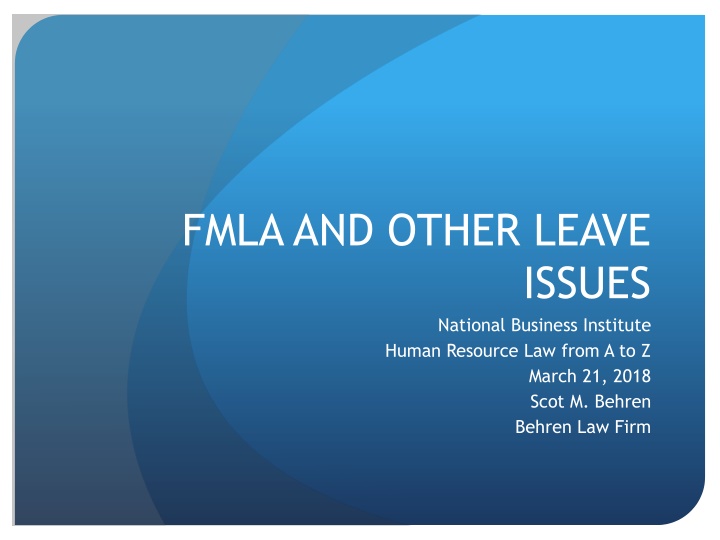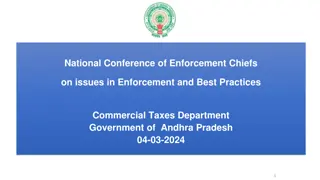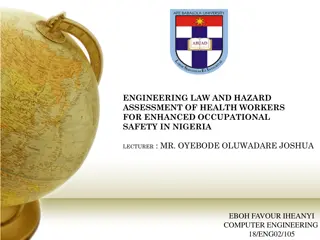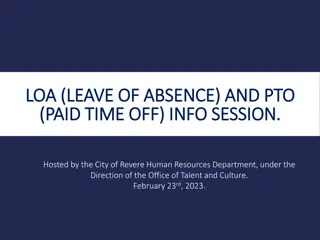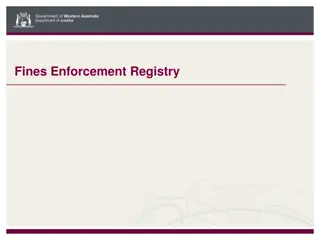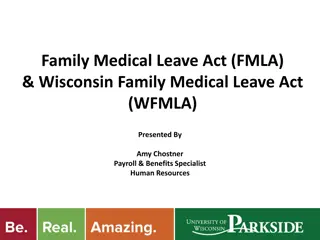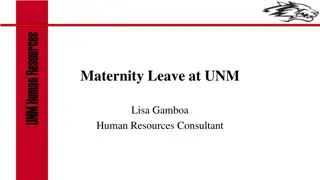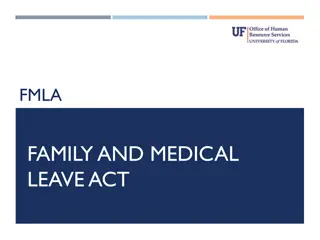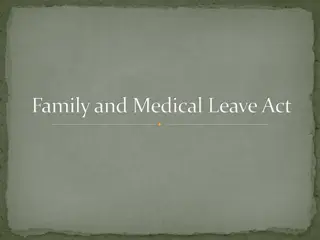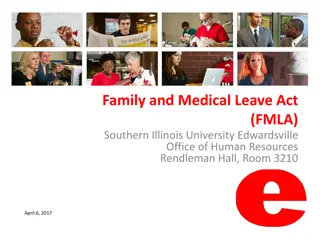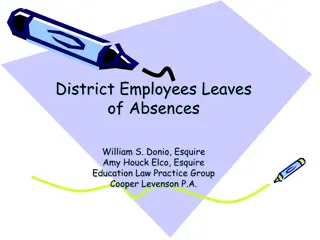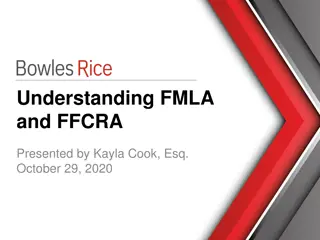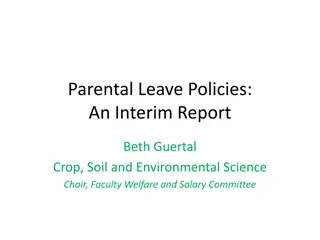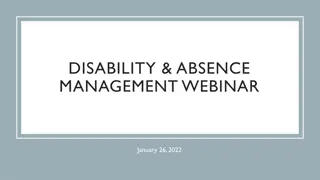FMLA Basics and Enforcement Guidelines
Family Medical Leave Act (FMLA) provides eligible employees with up to 12 weeks of unpaid leave for various caregiving reasons. Employers must adhere to FMLA regulations to avoid interference or discrimination against employees utilizing their rights. The U.S. Department of Labor oversees FMLA enforcement and employers must maintain compliance records.
Download Presentation

Please find below an Image/Link to download the presentation.
The content on the website is provided AS IS for your information and personal use only. It may not be sold, licensed, or shared on other websites without obtaining consent from the author.If you encounter any issues during the download, it is possible that the publisher has removed the file from their server.
You are allowed to download the files provided on this website for personal or commercial use, subject to the condition that they are used lawfully. All files are the property of their respective owners.
The content on the website is provided AS IS for your information and personal use only. It may not be sold, licensed, or shared on other websites without obtaining consent from the author.
E N D
Presentation Transcript
FMLA AND OTHER LEAVE ISSUES National Business Institute Human Resource Law from A to Z March 21, 2018 Scot M. Behren Behren Law Firm
Family Medical Leave Act FMLA basics Entitles an eligible employee employed by a covered employer to take up to 12 weeks of unpaid leave in any 12 month period for the birth and care of a new-born child, for the placement of a child for adoption or foster care, or to care for employee, employee s child, spouse or parent with serious health condition When FMLA leave is taken, eligible employee is to be restored to the same or an equivalent position with equivalent pay, benefits, and working conditions upon return from leave
Family Medical Leave Act Employer must continue to maintain health benefits for employee on FMLA Leave as if employee had not gone on leave Employee must provide employer 30 days advance notice of the foreseeable need for leave or such notice as is practicable where leave will begin in less than 30 days Employer entitled to require employee to provide certification from a health care provider to substantiate that the leave is for an FMLA qualifying reason
Family Medical Leave Act Enforcement of FMLA is delegated to the U.S. Department of Labor which can investigate and file complaints Prohibition on an employer from interfering with or restraining or denying the exercise or attempted exercise of any right under the FMLA Prohibition on discrimination against an employee who has instituted or participated in a proceeding relating to any right under the FMLA
Family Medical Leave Act DOL prescribes regulations on how FMLA should be interpreted DOL can handle investigations as with the FLSA Employers are required to keep and maintain its records pertaining to compliance with the FMLA Employers are required to post in a conspicuous location a notice for employees explaining the provisions of the FMLA and how to file administrative complaints alleging FMLA violations
Who is Employer Under FMLA Employer must be engaged in commerce in any industry or activity affecting commerce; and Employer must employ 50 or more employees for each working day during 20 or more calendar workweeks in the current or preceding calendar year 50 or more employees is based upon employers payroll and includes FT, PT employees and those who are employed but on some type of leave Bona Fide Independent contractors are not included in the calculation
Who is Employer Under FMLA Integrated Employers Separate entities (i.e. subsidiaries) under the FMLA will be considered a single employer under the FMLA if the entities meet the INTEGRATED EMPLOYER TEST. Under the Integrated Employer Test the entire relationship between the entities is considered including: Common Management or Boards and Directors; Common Offices, bank accounts, recordkeeping, equipment; Common ownership and financial control
Who is Employer Under FMLA Joint Employers Where two or more businesses exercise some level of control over an employee they may be joint employers under the FMLA If Employee does work that benefits more than one employer, joint employment relationship might be found where: There is agreement between employers to share an employees services; The employers share direct or indirect control over employee Also a fact intensive inquiry
Who is Employer Under FMLA Successors in Interest The FMLA includes successors in interest Fact intensive inquiry but some factors include: Continuity of same business operations; Use of same office or plant Continuity of workforce Similar jobs, working conditions and supervisors
Who is Employer Under FMLA Successors in Interest Similar machinery, equipment, etc. Similar products or services Where employer is successor in interest, they are required to count employees service to prior company for FMLA qualification
Who is Employer Covered Under FMLA Individuals As with FLSA, there can also be individual coverage under FMLA An individual is a covered employer under the FMLA and liable where it is a person who act, directly or indirectly in the interest of the employer As with FLSA, many courts have held individuals to be liable for violations of FMLA, including corporate officers, human resource directors and managers
Who is Employee Under FMLA An Eligible Employee Under the FMLA Must have worked for a covered employer for at least 12 months; Must have worked for at least 1,250 hours during the 12 month period immediately preceding the date leave is taken; and At a work-site where the employer employs at least 50 employees
Who is Covered Employee Under FMLA Measuring 1,250 Hours of Service Same principles as under FLSA, is number of hours worked by employee under the FLSA Hours not worked such as leave time do not count, but overtime hours worked would count If employer does not maintain records for employee as required by FLSA, employer has burden of showing that employee has not worked the required number of hours
Types of Leave Under FMLA Because of birth of a son or daughter and for care of a newborn child; Because of placement of a son or daughter with the employee for adoption or foster care; To care for relatives with a Serious Health Condition Because of employee s own Serious Health Condition A covered employer also must grant an eligible employee who is a spouse, son, daughter, parent, or next of kin of a current member of the Armed Forces, including a member of the National Guard or Reserves, with a serious injury or illness up to a total of 26 workweeks of unpaid leave during a single 12-month period to care for the service member
Types of Leave Birth or Care of Newborn Entitlement applies to both male and female employees who need leave for newborn child Before birth of child, mother may take leave for serious health condition due to pregnancy and father may take leave to care for wife s pregnancy related condition Employee s entitlement this leave for newborn expires 12 months after newborn s birth If married mother and father work for same employer, they only get total of 12 weeks leave
Types of FMLA Leave Adoption or Foster Care Placement Leave to be provided to leave to employee to facilitate adoption or foster care Leave should be granted for counseling sessions, consults with legal counsel, meeting with birth parents and for bonding time with the new child As with pregnancy, leave terminates 12 months after placement of child through adoption or foster care If married parents both work for same employer, only 12 weeks total leave provided to both
Types of FMLA Leave Serious Health Condition of Family Member Applies to care for spouse, son, daughter or parent of the employee Parent is defined to include adoptive, step and foster parents (not in-laws) Son or daughter is defined to include a biological, adopted, or foster child, a stepchild, a legal ward, or a child of a person standing in loco parentis, who is either under age 18, or age 18 or older and incapable of self- care because of a mental or physical disability at the time that FMLA leave is to commence.
Types of FMLA Leave Serious Health Condition of Family Member Employer may require employee to provide reasonable documentation or statement of family relationship (i.e. birth certificate or court order) to care for is not defined, but employer may require employee to provide medical certification of what care is needed for relative of employee
Types of FMLA Leave Employee s Own Serious Health Condition Employee must establish both a serious health condition and the inability to perform the essential functions of a particular job An employee is unable to perform the functions of the position where the health care provider finds that the employee is unable to work at all or is unable to perform any one of the essential functions of the employee's position within the meaning of the Americans with Disabilities Act (ADA). Employer may require employee to provide medical certification where health care provider sets forth which essential functions can or can t be performed.
FMLA-What is a Serious Health Condition? For purposes of FMLA, serious health condition entitling an employee to FMLA leave means an illness, injury, impairment or physical or mental condition that involves inpatient care or continuing treatment by a health care provider Inpatient care means an overnight stay in a hospital, hospice, or residential medical care facility, including any period of incapacity
What is a Serious Health Condition? Continuing Treatment by Provider A period of incapacity of more than three consecutive, full calendar days, and any subsequent treatment or period of incapacity relating to the same condition; Any period of incapacity due to pregnancy, or for prenatal care. Any period of incapacity or treatment for such incapacity due to a chronic serious health condition. A period of incapacity which is permanent or long-term due to a condition for which treatment may not be effective (i.e. Alzheimer's)
What is a Serious Health Condition? Continuing Treatment by Provider Any period of absence to receive multiple treatments (including any period of recovery therefrom) by a health care provider or by a provider of health care services under orders of, or on referral by, a health care provider (i.e. surgery after an accident or injury, chemotherapy, radiation, severe arthritis and/or kidney disease)
What is a Serious Health Condition? Leave for Substance Abuse Treatment Substance abuse may be a serious health condition. However, FMLA leave may only be taken for treatment for substance abuse by a health care provider or by a provider of health care services on referral by a health care provider. Absence because of the employee's use of the substance, rather than for treatment, does not qualify for FMLA leave. An employee may also take FMLA leave to care for a covered family member who is receiving treatment for substance abuse. The employer may not take action against an employee who is providing care for a covered family member receiving treatment for substance abuse
Are Cosmetic Surgeries Covered Under FMLA? Generally not considered serious health conditions, but if medical complications arise can become serious health conditions subject to FMLA
What is a Serious Health Condition? Mental Health Conditions Regulations provide that mental illness resulting from stress or allergies may be covered under FMLA if other conditions of FMLA are met Employee must also be granted leave to care for family member suffering from mental illness
Length and Scheduling of FMLA Leave Employee is Entitled to 12 workweeks of FMLA leave in a 12 month period The length of FMLA leave may provide more time pursuant to state laws, collective bargaining agreements or more generous employer policies
Length and Scheduling of FMLA Leave Measuring the 12 Months Calendar year; Any fixed 12 month period such as fiscal year or employee anniversary date; A rolling 12 month period measured backward from the date the employee uses any FMLA leave; Except as otherwise may be required by state laws Whatever method is used must be uniformly applied If changed employees must be given at least 60 days notice
Intermittent and Reduced Schedule FMLA Leave Employee may take FMLA intermittently, a day or hour at a time Employee may take FMLA by working a reduced schedule (i.e. going from full time to part time) Employee may only take intermittent leave without employer approval if needed to care for serious health condition of self or family members Employee may take intermittent leave for birth or adoption only if approved by employer
Intermittent and Reduced Schedule FMLA Leave Employee s eligibility for intermittent leave is determined when the leave commences, employee does not need to re- qualify each time intermittent leave is sought Employer may ask employee to advise of reasons for intermittent leave and to give schedule of medical treatments Employer may require medical certification which includes probable duration of condition, duration of required intermittent leave, any chronic conditions, likely duration of incapacity New certifications may not be requested for each absence
Intermittent and Reduced Schedule FMLA Leave Employer may require employee to schedule medical treatments in manner that will not unduly interfere with operations of employer Employer MAY NOT INSIST THAT EMPLOYEE PROVIDE A FIRM SCHEDULE of when he/she will use intermittent leave
Intermittent and Reduced Schedule FMLA Leave Only the amount of nonwork time actually taken by employee may be counted towards FMLA For instance, if employee is working from home, whether authorized or not by employer, this is not considered FMLA time Employer may not impose limits on the increments of time taken for intermittent leave, for instance, employer may not require employee to take at least one half day at a time
Intermittent and Reduced Schedule FMLA Leave If an employee requires intermittent leave and meets the criteria, employer may not deny it even if a hardship However, employer may transfer employee to an alternative position that better enables employer to accommodate the leave Job Transfer need not have equivalent duties, but must provide pay and benefits equivalent to employee s original position Employer may not eliminate benefits to employee even if leave reduces employee to part time and part time employees would not normally receive these benefits
Intermittent and Reduced Schedule FMLA Leave Job transfer to accommodate intermittent leave may not be done to dissuade employee from taking leave Job transfer to accommodate intermittent leave may not work a hardship on employee Once employee no longer needs intermittent leave, employer must reinstate employee to same or equivalent job as when leave commenced
FMLA Notices and Certifications Must post FMLA rights for employees If employer has employee handbook, it must include FMLA rights, responsibilities and policies of employer. For instance, if employer requires a fitness for duty certification to return to work the handbook should explain this policy If no employee handbook, employer must provide employees with written guidance on their rights under the FMLA Where employer fails to post required FMLA notice, it may not take action against employee who does not provide advance notice of need for leave
FMLA Notices and Certification Notice by Employee of Need for Leave If foreseeable by employee, at least 30 days advance notice If leave unforeseeable by employee, as soon as practicable In giving notice of need for leave, employee need not mention the FMLA but must give employer information to make it aware that it may be FMLA qualifying-at least a possible FMLA leave situation If some sort of need for leave is not requested, employer need not furnish it
FMLA Notices and Certification Employer Response to Notice Employer must notify employee that leave being sought will be designated and counted as FMLA leave Once leave is requested employer must provide employee with the employee s obligations under FMLA including: whether leave will be counted against FMLA; any requirements for medical certifications; employee s right to take leave as paid leave; whether employee will be required to pay health insurance premiums; whether employer will require fitness for duty certification before return to work; the employee s right to be restored to same position upon return; employees liability for repayment of health insurance premiums during leave
FMLA Notices and Certification Employer Response to Notice Employers response must be given to employee in plain language and as promptly as possible
FMLA Notices and Certification Medical Certifications and other Notices FMLA permits but does not require employers to seek medical certifications to support a serious health condition FMLA permits but does not require an employer to obtain fitness for duty certifications, documentation of family relationships and/or notices of intent to return to work DOL has form for medical certifications, employer can use form or one requesting same basic information
FMLA Notices and Certification Medical Certifications and other Notices In Medical Certification Employer may only obtain information relating to particular condition for which leave is sought May not obtain medical records If there is question of validity of medical certification, circumstances may permit employer to seek second and even third health care provider opinions If employee is on leave for extended time or takes leave intermittently, employer may require recertification of medical condition on reasonable basis (generally not more often than every 30 days)
Pay and Benefits During Leave Substitution of Paid Leave Employee may request that accrued paid leave such as vacation or PTO be used in lieu of FMLA IF Employee does not elect it Employer may require employee to use paid leave time for FMLA
Pay and Benefits During Leave Maintenance of Benefits Employer is required to maintain group health insurance coverage for employee on FMLA leave on same terms and condition as if employee had stayed at work Employer must continue to pay portion of premium previously paid, but needs to let employee know of what payments must be paid during FMLA leave In most cases obligation to maintain benefits ceases upon termination of FMLA leave Non health benefits must also be continued during FMLA leave
Restoration of Employee after FMLA Leave Employees shall be entitled to return to former position held when FMLA was taken; or Employees must be restored to equivalent position with equivalent benefits, pay and other terms and conditions of employment Employee is entitled to such reinstatement even if the employee has been replaced or his/her position has been restructured to accommodate the employee s absence
Restoration of Employee after FMLA Leave Restoration is not absolute however, for instance, employee can be laid off if lay off would have resulted regardless of taking of FMLA Leave Poor performance or misconduct prior to leave may provide basis for denial of restoration rights provided that employment would not have continued if FMLA leave had not occurred
Restoration of Employee after FMLA Leave If employee held other job during FMLA leave, not necessarily a basis for termination upon return If employee advises employer of intent not to return to work, employer may terminate employee Employer may refuse reinstatement until after receipt of fitness for duty certification so long as this is uniformly applied policy If Employee fraudulently obtains FMLA leave (i.e. false medical information) this may be basis for refusing reinstatement
Restoration of Employee after FMLA Leave Expiration of 12 Weeks FMLA does not require employer to restore employees who are unwilling or unable to return to work and perform the essential responsibilities of their position upon return
Interference Under the FMLA No employer may interfere with, restrain or deny the exercise of or the attempt to exercise any right provided under the FMLA The Interference Theory Easier type of case to prove by employer, employer must only show that he/she was entitled to the benefit denied
Retaliation Under the FMLA FMLA makes it unlawful for an employer to discharge or in any manner discriminate against any individual for opposing any practice made unlawful by the FMLA An employer may not use employee s FMLA use as a negative factor in making any employment decision Uses McDonnnel Douglas test used in discrimination cases including proof of pretext by employer
Relevant Cases Sarah Dykstra v. Foreclosure Attorneys PLLC, 183 F.Supp.3d 1222 (S.D. Fla. 2016) Employee returning to work provided Fitness for Duty Certification indicating ready to return with light duty Court denied Motion to Dismiss, in that an employee may ask to return to duty and still perform essential functions of job even with light duty restrictions Under ADA an impairment in remission or episodic may qualify as disability if impairs major life activity when active
Relevant Cases Maryline Avila v. Escambia County Clerk, 212 F.Supp.3d 1182 (N.D. Fla. 2016) Dismissal of FMLA Retaliation and Interference Claims Not sufficient notice to Employer of need for FMLA leave Employers responsibility only starts if Employee lets them know, no burden for employer to look into every circumstances of employee sickness
Americans with Disabilities Act Title I pertains to employers and job seekers Applies to those with physical or mental disability that substantially limits one or more life activities Has a record of such an impairment or Is regarded as having such an impairment Also can cover associational disability (i.e. discrimination based upon taking care of family member)
